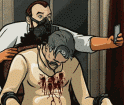|
So the ways I can think of to convert resources to points: Agricola: buy improvements, build up a personal board of stuff A Feast for Odin: build boats, buildings, some cards let you convert resources to stuff Keyflower: have some buildings that are worth points, more points if you get certain resources, flip them using resources for more points Marco Polo: contracts for resources -> points, some buildings let you convert them, worth a flat number at end of game Just going by some other worker placements.
|
|
|
|
|

|
| # ? Jun 7, 2024 16:38 |
|
I think part of my problem had been I set out with this "let's make VP in a worker placement game feel more organic" and the whole 'give buildings different victory point values which could double as gold costs to remove them from the market row' solution is staring me in the face and I've been too stubborn to just accept that the reason a lot of worker placement games use VP like they do is because it works.
|
|
|
|
Why is it do the buildings feel clumsy and terrible? If you can pin-point the reason, is there a way you can alter them to get rid of that feeling? What is your ideal experience you're trying to achieve with the buildings / the game in general? This doesn't need to be super detailed, just something like "players need to solve a puzzle of how to get the most resources in a limited number of turns." Then think about how the buildings work toward that experience , and how you can change them to better suit it. Finally, if gathering resources is fun and interesting, why not just make that the entire goal of the game? Different resources could be worth different amounts of points at the end or something.
|
|
|
|
Kashuno posted:I am getting a serious lack of satisfaction from my design lately, and I feel like I'm slamming my head against a wall trying to figure out a way to make it more fun. Gathering resources feels fun and engaging for everyone; it has gotten glowing feedback with how strategic while being easy to understand it is, especially after the most recent playtest. I feel like that mechanic is solid and tuned to the point that it works (close to) perfect Then you get to "what to do with the resources" and it drops off a cliff. I've tried a few different ways to make "resources create buildings that generate points" to be entertaining and interesting, and while the buildings themselves feel interesting and create good play, there is just something about it that feels clumsy and terrible. Two questions for your game: 1: Is there a way to tell who did the best resource gathering? 2: Is the player who did the best resource gathering the one who had the most fun or played the best?
|
|
|
|
CodfishCartographer posted:Why is it do the buildings feel clumsy and terrible? If you can pin-point the reason, is there a way you can alter them to get rid of that feeling? The worst submarine posted:It might feel clumsy and terrible because the building section is not the fun part - you're adding a big component that stops people from getting back to the fun stuff. If resource gathering is already fun and engaging you don't need to add more depth, just reward people for doing a resource gather good. right now the general gameplay flow works like this: Players place tiles to create resource deposits, with more of the same resource type touching each other generating more resources for the player. Once a tile has a worker placed on it to gather resources, the tile is flipped over to a tile that no longer generates resources but can have a worker placed on it to build a building. Players can then place workers on those tiles in order to build buildings which generate victory points, as well as have unique abilities when workers are placed on them and can be chained together. To me, it feels clumsy because a general market row is a boring band-aid to a problem I had a while ago that was more of a component cost and readability issue than a gameplay issue. I've tried so many ways to get that same feeling back with a smaller component cost, but it just doesn't feel like it has been working out. I may scrap the second half entirely and keep the core of the tile placement with a different end goal. I actually had never considered just making the resource gathering the entire game, and I can't think of how to make that work right away, but I may consider that. Change the overall theming of the thing and go from there. Right now, there is no way to really tell who did the best resource gathering. I will keep the second question in mind for future tests! e; Hm. I'm going to probably revise things a little bit, but I'm thinking of a re-theme that would make player combat a component of the game. Rather than resources, it would be a magic themed game where players are using their workers to gather mana of a particular color. Once a space has been used to gain mana, the space would flip over into a space that can be used to cast magic. Spells available would be chosen at the beginning of the game, with all spells having a 'base' ability and an 'advanced' ability that would be somewhat tied to elemental affinity (for example, a fire spell may damage an opponent whereas a wind spell may defend, or an earth spell could generate extra mana, with advanced abilities combining multiple elements). This keeps the resource gathering mechanic that has been working well in the game, reduces the component count significantly, gives all the resources actual use cases, and makes the secondary mechanic feel more related to the first than they currently are. I don't know how this will work out, but I think it's worth a test. Thanks for the insight gang, you folks really got me thinking about this from a different angle. Kashuno fucked around with this message at 18:07 on Nov 6, 2017 |
|
|
|
Kashuno posted:I think part of my problem had been I set out with this "let's make VP in a worker placement game feel more organic" and the whole 'give buildings different victory point values which could double as gold costs to remove them from the market row' solution is staring me in the face and I've been too stubborn to just accept that the reason a lot of worker placement games use VP like they do is because it works. Also think about what AFfO does with VP:Silver:Ships, too, if you're going to have some kind of way of using resources to purchase things which are worth points. Ships in AFfO are really only worth net points if you build them. Another way to make VP feel more "organic" is to make it a resource collection/generation thing, the way that money works in games like 18xx or FCM - you spend that money to develop your tableau, and then that tableau generates more money. Whatever you call it, play money in games is just VP. This is also kinda visible in Terra Mystica in how the Alchemists function. From what you describe in your subsequent posts, turning VP into money and treating it as a flexible resource (don't have the lumber required to make a building? convert money to lumber.) might be the answer.
|
|
|
|
CommonShore posted:Also think about what AFfO does with VP:Silver:Ships, too, if you're going to have some kind of way of using resources to purchase things which are worth points. Ships in AFfO are really only worth net points if you build them. I had buildings designed that did that kind of resource conversion thing, and had considered using one of the resources as a VP type deal but it never felt like it was well done. I may end up revisiting the building idea if the retheme above doesn't change things, but I think the two mechanics are too far disparate for me reconcile them. I've gotten feedback a few times over the last couple weeks that has amounted to "it feels like I am playing two completely separate games" which is sadly what I think it became. Two ideas for two separate things that have some mechanical similarity but ultimately are separate ideas. I don't think that's a problem though; if one does well perhaps I can revisit the second as a possible game idea with a similar, but different, mechanical backbone.
|
|
|
|
Kind of an extension of the last post, but I've modified things a bit to create a different game that, on paper, looks more coherent and fun throughout. Players will generate mana by using mana tiles, laid down each turn by players. They can summon additional workers for a cost, and to place their living workers past the first 3, they must pay one mana. Each worker has 3 health. Gathering mana will flip mana tiles, converting them to spell circles that players can use to cast magic for a variety of effects. The game ends when all the tiles from the mana deck are drawn, and players spend the game attempting to kill other workers on the board. Worker health is added to a pool, and every time it passes a denomination of 3 a worker that player controls will die. Workers can be resummoned. The winner has the most remaining workers; if there is a tie, the most remaining health. It's significantly different than my previous game, and a bit more cutthroat, but I think it makes the two mechanics feel connected rather than disparate, and really adds to the strategic placement of mana reserves and spell circles. I hope it turns out as well on paper as it does in my head right now thanks again yall
|
|
|
|
I came up with a game a few months ago where one player's blindfolded the entire time and the other players try to convince blindfoldee to pick the cards that help them the most, and it has only now occurred to me that its long-form Win, Lose, or Banana.
|
|
|
|
So I'm spinning my wheels on Contract. Found an even more degenerate strategy. I need to do some serious rebalancing, but that means either moving back to an ugly prototype (which will get less play), or another trip to the print shop and  . .I've also been brainstorming another project. It's a real disparate idea right now. But essentially I want to try and make a dudes on a map / area control / deckbuilder / action-selection thing. The idea I have is roughly that you start with a few actions, one of which lets you follow an opponent's action, and use actions to acquire territory (which provides income?). I also am thinking of using blind bids to resolve combat. With you gaining a penalty resource equal to your bid, win or lose. This idea is still really shaky. I need to just throw together a prototype but I can't seem to get enough thought out to get it down. Are there multiple types of mana? Or is the game reduced to just one resource? I would think it would lose a lot of the planning aspect without there being multiple resources, which seems like a shame. Other than that (unfounded?) worry, I think this actually sounds really neat. Though might it be easier to give Workers (Apprentices?) two health. One side is healthy, one side is wounded, off the board is dead - it would let you track health worker by worker, which would allow you to have range/positioning matter for spells? The horror...
|
|
|
|
I'm planning on using BoardGameMaker.com to make a demo version of my game so I can create a sizzle reel and shop it around. Does anyone have an alternate recommendation?
|
|
|
|
Sooo I didnít have a chance to make any major retooling before playtesting tonight, and in the end Iím happy I didnít. Other than some quick cost changes and changing one of the resources to a wild, I played it straight. People seemed happier with the building mechanics now that building isnít as punishing, and it seemed to happen much more frequently. It felt a lot less disparate and the buildings actually added content rather than pulling from it. Now that both mechanics seem to be going over well, there is some fine tuning and unique stuff that I can test, and Iím really finally excited to get this game to the next steps rather than dreading it. All I needed to do was make every single building cost 1 less, add a very simple scaling point system, and it felt so much smoother. I donít know why I didnít think of this sooner. The moral of this story is sometimes itís better to use a pair of scissors than light your whole game on fire.
|
|
|
|
But did you move it back to more than one tile per worker placed?
|
|
|
|
|
silvergoose posted:But did you move it back to more than one tile per worker placed? Per your guys suggestion, tried the number of workers plus 1 and it worked surprisingly well! Toying with another tile placement idea and different tile designs from here on, but at least it feels much better
|
|
|
Kashuno posted:Per your guys suggestion, tried the number of workers plus 1 and it worked surprisingly well! Toying with another tile placement idea and different tile designs from here on, but at least it feels much better Swank, really glad to hear it! See, trying out completely broken rulesets is useful! 
|
|
|
|
|
So I have two game ideas that I've been dwelling on for a while and I think I want to make a stab at developing both of them, somehow. I need some "how to get started" tips and feedback on my basic concepts. 1) Originating in a conversation with a friend, I have an idea for a Judo-themed two-player strategic card game. The core mechanical concept is a hand management game about pushing toward a victory threshold via combinations of cards, with an opponent able to expend cards to defend, but that the game is two-phase - standing and ground. Failure to achieve that threshold on an attempt will switch the game to the other phase, potentially leaving a player with exhausted resources and an opponent who is now in position to counter-attack. My idea (which I haven't seen implemented elsewhere) is to achieve this by giving each card two functions, one for each phase, and when the phase switches, players physically invert the cards in their hands, to work from the other end (i.e. the text is upside down in relation to the other). I want the game to create are where a player is hypothetically able to play the last card in his/her hand to attempt to win in a standing fight, but recognizes that if the attempt fails due to an opponent's defensive play, which may or may not be available, that he/she could find him/herself on the ground facing an opponent with powerful cards. I want this game to be medium-light and easily portable. 2) I have a sweet idea for a COIN game based on the Canadian North-West Rebellions, and I've gotten some feedback from people on the very basic concept, and it makes me want to fiddle with it a bit more to see if I can make something of it. I'm not really sure what the next step should be in attempting this beyond fantasizing "man we need a Gabriel Dumont card and one for Cut-Knife and maybe something with a railroad and pew pew yeeeaaaah" e. just reading my own post made me realize that this could be COIN+18xx 
CommonShore fucked around with this message at 22:23 on Nov 7, 2017 |
|
|
|
The first idea sounds really interesting to me. I would probably begin with deciding if you want to have the game be symmetrical or asymmetrical to start with, and the advantages and disadvantages to both. It's hand management, are you able to get new techniques in some way or recover spent cards?
|
|
|
|
When trying to make a game the size of the first one, I've found that one of my biggest pitfalls is making the game too complex (and therefore too hard to balance), and also requiring too many components. A good way around this is to intentionally limit yourself to a 52 card deck. It has a few benefits: it limits your possibilities (and forces you to try to get into that 'super compact' headspace), it's easy to prototype, and it guarantees that your game physically fits the dimensions you've considered for it. I've also found that having an easy to prototype game makes iteration and testing less painful.
|
|
|
|
Kashuno posted:The first idea sounds really interesting to me. I would probably begin with deciding if you want to have the game be symmetrical or asymmetrical to start with, and the advantages and disadvantages to both. It's hand management, are you able to get new techniques in some way or recover spent cards? Yep, I've been thinking about that. I want it to operate from one total deck, so that puts me in a total zero-sum position as far as design goes. Is there any way to introduce asymmetry to an environment like that? My "draft" approach to card draw is that at the end of the turn you draw one card up to a hand limit, no matter how many you spent. This has a thematic inspiration in the first place - if you fight hard you might get the finish, but you exhaust yourself; if you do less, you don't progress, but you get to rest. sector_corrector posted:When trying to make a game the size of the first one, I've found that one of my biggest pitfalls is making the game too complex (and therefore too hard to balance), and also requiring too many components. A good way around this is to intentionally limit yourself to a 52 card deck. It has a few benefits: it limits your possibilities (and forces you to try to get into that 'super compact' headspace), it's easy to prototype, and it guarantees that your game physically fits the dimensions you've considered for it. I've also found that having an easy to prototype game makes iteration and testing less painful. Oh yeah. My initial plan is 52 cards for that reason and more. This game is essentially a filler game, or something that people play at dinner or in the back seat of a car. To handle complexity, I'm thinking of keywording cards - technique A might be a "FOOT" technique, and technique B might have the function counters "FOOT" technique. Every keyword would just be a matching thing with no deeper rules. e. to expand (I had to switch locations mid post) the problem I'm having is determining good ways to measure my victory threshholds, and what a reasonable population of keywords would be. Is something like "maintaining a particular game state for two turns" a reasonable threshhold, for example? What should I do now in this? Worry about keywords and rules? Start designing cards? CommonShore fucked around with this message at 00:02 on Nov 8, 2017 |
|
|
|
CommonShore -  but with getting a prototype out. Your goal should always be to fail forward faster. Get a minimal viable product out and then iterate / refine until you have what you actually want. but with getting a prototype out. Your goal should always be to fail forward faster. Get a minimal viable product out and then iterate / refine until you have what you actually want.Hey so this is kinda topical, I recently started reworking my own take on a Fighting Card Game, although it is very different from CommonShore's idea, maybe there's some overlap that can be of use to you. The core goal of this game is to use one piece for as many things as possible. To this end your initial hand of cards is what you use to pay costs, launch attacks, and defend. Initially I had a really messy time system to track how turns passed between players and it just didn't really work, even though otherwise the game play seemed novel and interesting. I finally came back to the game with a new idea, the core resource would be Meter, instead of time. To this end, when you play an attack you build it as Face-Up Meter. When you Defend against an attack, you build those cards as Face-Down Meter. When you play attacks, you spend Meter (either Face-Up or Face-Down, with Face-Up returning to your hand and Face-Down being discarded.) Your goal is to launch an attack your opponent can't defend against, and in doing so, KO them. All cards have a Defense value, which represents how much of an Attack they prevent when built to Meter Face-Down. Does anyone know of any similar-ish ideas I could maybe mine for material? Right now the game suffers a little from being so narrowly focused. I've got a few ideas for expanding on the core experience with additional content, but it all hews pretty close to the core formula and design principles. One issue I ran into with my first play test was that it was possible to accumulate a ton of Meter and not really have anything to spend it on, or to literally completely run out of cards such that neither player can act, which I fixed by adding Basic Moves that are on your Character Cards that allow you to do things without spending Meter / having cards in hand. Meter Rules posted:Game Objective I'd include some pictures, but I have literally the worst experiences trying to get SA to accept images. So ideas I'm experimenting that expand from this core concept: -Cards that launch multiple attacks that have to be defended against individually -Dazing attacks that let the attacker pick a card the defender must defend with, provided its defense is less than or equal to the attacks power -Blocks that you can Defend with while they are Face-Up Meter (which flips them Face-Down) -Stances that give you a benefit while Face-Up in Meter or that let you turn them Face-Down to activate a more powerful effect (not totally sure how I'm going to implement this one honestly) -Combos? That let you play follow up actions with reduced Meter Cost? Or get more powerful as follow ups? -Cards you can flip Face-Down while Face-Up in Meter for some effect? (Sort of like Block and Stance, but more flexible) -Devastating attacks that discard the cards used to defend against them (instead of adding them to Meter) That's awesome. Congratulations on finding a way to save what you had done!
|
|
|
|
Anniversary posted:Does anyone know of any similar-ish ideas I could maybe mine for material? Right now the game suffers a little from being so narrowly focused. I've got a few ideas for expanding on the core experience with additional content, but it all hews pretty close to the core formula and design principles.
|
|
|
|
The worst submarine posted:This description reminds me a lot of Mage Knight's combat. If you can recreate the puzzle feeling of Mage Knight without the half hour of setup and multiple hours of play, that would be amazing. Oh man, I love Mage Knight and would love for the comparison to be apt, but I'm too close to this to be able to tell. I'll try and get a game in with the friend who introduced me to MK to see if they get that feel. Also I guess I could add elemental attacks and defenses if I wanted to make things more complex... That said I'm not sure if the comparison holds, as this has a back and forth flow that spreads out decisions more than MK's combat does.
|
|
|
|
CommonShore posted:
 I actually want to see a COIN+investment game too. Either 18xx for route building and investments or just pure imperial-style investments. So like Imperial with Here I Stand. I actually want to see a COIN+investment game too. Either 18xx for route building and investments or just pure imperial-style investments. So like Imperial with Here I Stand. 
|
|
|
|
I've designed the "Standing" half of 52 cards, and now I'm working on the concepts for the "Ground" half. I've been amazed how much the rules have been changing as I've just been coming up with card concepts. Chill la Chill posted:
That's why the North-West Rebellions are the perfect historical setting for the concept - it's a mixed conventional and guerilla insurgency with four distinct factions, and the government's end goal is to stabilize the region via a railroad which will allow white colonization.
|
|
|
|
Chill la Chill posted:
I want to see one purely for the "coin" + investment pun
|
|
|
|
Is there any board/card game specifically designed for correspondence play? I've wanted to make a correspondence game because my friends and I like playing games together and thinking hard, but we're all pretty busy and have trouble meeting up.
|
|
|
|
The first game of our design/testing group has been published (Dutch only so far)
|
|
|
|
|
Osmosisch posted:The first game of our design/testing group has been published (Dutch only so far) Congratulations that's exciting!
|
|
|
|
Back from PAX Unplugged! I had an awesome time testing at the UnPub event, and I highly recommend doing an UnPub in the future if you ever get a chance. Got some great feedback on some of the more recent changes I've made, and people really seemed to love it overall. I have a few small things I want to change, but I think this game is ready for a fullblown prototype!
|
|
|
|
Just wanted to second Kashuno's post about Unpub at PAX. I had about 10 playtests for a reach of about 30-35 players in one day which was great, especially since those playtests average out to 45 minutes each plus feedback time. It was also great to network with some reviewers, Panda, Longpack, GPI, Kickstarter and a few other relevant people/places. Looking forward to doing my first big push at Origins, and then just continuing on with public playtests/community building at smaller conventions between now and then. The exhibitor badge I got for running D&D there was absolutely magical for getting access to all of those people when they weren't busy and in a pretty relaxed state. I'm still trying to figure out the best way to handle combat in my game but pretty much all the other pieces of it are fitting together pretty nicely.
|
|
|
|
Does anyone have any recommendations for prototyping a tile laying game? I feel like Amazon should have an 'assorted unfinished wood squares and rectangles' pack, but I can't seem to find it.
|
|
|
|
sector_corrector posted:Does anyone have any recommendations for prototyping a tile laying game? I feel like Amazon should have an 'assorted unfinished wood squares and rectangles' pack, but I can't seem to find it. Oh boy hello there. For a prototype, is there a reason you're going for an assorted packed of different size wooden tiles? Generally, you can find blank tiles in packs like this for prototyping; I used a few packs of these for testing purposes and they worked great.
|
|
|
|
Kashuno posted:Oh boy hello there. For a prototype, is there a reason you're going for an assorted packed of different size wooden tiles? Generally, you can find blank tiles in packs like this for prototyping; I used a few packs of these for testing purposes and they worked great. I'm not married to wood, but I've had good luck with unfinished wood as a material for other bits. That seems like it might work pretty well. I'd like to have assorted sizes because my idea is sort of similar to Mad King Ludwig, with its different varieties of rooms connected by rectangular paths.
|
|
|
|
I've had some luck with those little cardboard tiles and gluing them to paper in a variety of shapes. Can be a bit of a pain in the butt, but it works for cheap!
|
|
|
|
You can always buy some poster board from a local office supply store, then draw on / cut out tiles from it. Makes it super easy to play with different shapes and sizes.
|
|
|
|
So I ask because I'm returning to my Betrayal rework, and one of the big sticking points still is that rooms aren't very 'fun'. I'm thinking tile laying is a cooler mechanic than anything I've come up with so far. One problem with tiles is limited information. I don't like Betrayal's approach to this (a bunch of interconnected rooms - some blank, some with information), and I think a Ludwig style tile laying system with a patchwork style queue is maybe a good approach. However, I'd like for rooms to 'do stuff', and need a place to put that information. This originally lead me away from my initial idea of tile laying within a grid. So one possibility would be to have an 'atlas' type element, which is a (in the final version) heavily designed book that's decorated and provides flavor for the game's world, and maybe even incorporates some ideas I have from another project where a book serves as the game board. Regardless, do you all think it's too cumbersome to have a companion text that factors heavily into the game? I'm thinking it might be a good way to offload some text and make it more readable in general.
|
|
|
|
I had an idea last night: Lego would work really, really well. Luckily I'm at my parents' house for the holidays and have access to all of my old bricks from when I was a kid.
sector_corrector fucked around with this message at 19:18 on Nov 24, 2017 |
|
|
|
Lego are the thinking man's board game components
|
|
|
|
This weekend I went ahead and made a website, facebook page, twitter account, instagram, and mailchimp newsletter for the game I am developing and the LLC I am creating to produce it. I would love any feedback you all have on the site and just in general other tips you all have for promotion. My graphic designer is working on a logo and such for the LLC. I have an illustrator but am not going to have any art from her until January at the earliest, so for now it will stay to the blog format. I also just submitted an application for Entrepreneur's Alley at Gen Con since it works out to be a better deal IMO than doing the Exposure Hall there, and being just before when my kickstarter should go live seems to be a great time for a last minute in person promotion drive. http://hitemwithashoe.com/
|
|
|
|

|
| # ? Jun 7, 2024 16:38 |
|
So in a playtest last night some of the players brought up that it might be good to completely eliminate luck from combat to make this game appeal to the euro crowd as much as possible. I thought this was an interesting idea and at least worth thinking about, but I am not sure how to implement it. Perhaps everyone has cards with a certain value they have to expend and don't get back? Maybe betting, where the attacker bets workers but the defender can bet resources and workers? It needs more thought, but I figured I would check here for ideas as well. Here is how PVP combat currently works (how this would affect PVM is a totally different question): Player vs. Player Both players roll a D6 and adds that number to the number of bees used in the robbing action (attacker) or all of their unassigned workers and/or workers with the defend action (defender). Highest result wins. Ties go to the defender.
|
|
|
























